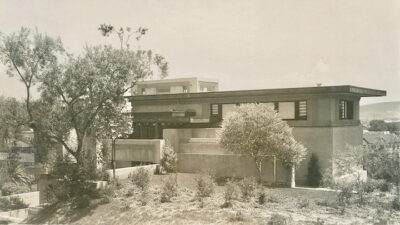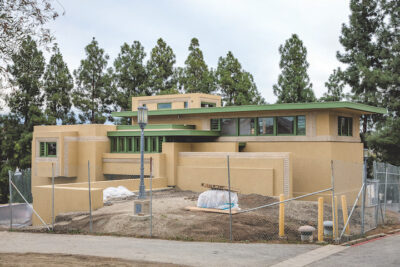Phase 1 of Frank Lloyd Wright ‘Residence A’ rehab complete

HOLLYWOOD SIGN and Griffith Observatory are backdrops for Barnsdall Park event that included, from left: Acting General Manager of the city’s Department of Cultural Affairs Daniel Terica, Hollyhock House curator Abbey Chamberlain Brach, Chief Deputy City Engineer Deborah Weintraub, General Manager of the city’s Department of General Services Tony Royster and Councilmember Mitch O’Farrell.
The architect Frank Lloyd Wright designed a number of famous houses in Los Angeles. The first was Hollyhock House, built between 1919 and 1921 for oil heiress Aline Barnsdall on her 36-acre Olive Hill property above Hollywood Boulevard, on the west side of Vermont Avenue. She commissioned Wright to build a Mayan-inspired theater, cinema, commercial shops and artist residences as part of a cultural arts complex she envisioned. Barnsdall donated the property to the City of Los Angeles in 1927, allegedly because she was concerned about the costs of maintenance and additional planned construction.
Ginny Kazor
Among the important city stewards of Hollyhock House was the late Ridgewood-Wilton leader, Virginia “Ginny” Kazor, as reported in the Larchmont Chronicle in August 2019, after the house was declared a UNESCO World Heritage Site (the only one in Los Angeles). Kazor, as a staff member in the City of Los Angeles Department of Cultural Affairs, started overseeing Hollyhock House in 1978. She long had been involved nationally in preserving the work of Frank Lloyd Wright, including as a founding member of the Frank Lloyd Wright Building Conservancy. She died in September 2021.
Residence A
The Hollyhock House curator today is Abbey Chamberlain Brach. Brach was among the speakers at a December 15 event organized by 13th District City Councilmember Mitch O’Farrell to celebrate the completion of the first phase of the restoration of a second Wright building on the property, “Residence A,” originally completed in 1921. Said Brach of these Frank Lloyd Wright buildings: “These landmark structures represent not only what was built on Olive Hill, but the grand plans Aline Barnsdall and her architect conceived for an arts community here…
“In 1927, when Ms. Barnsdall gifted the park to the City of Los Angeles, she said, ‘I thought of my father, of the happiness of children and young people with Olive Hill as a place to work and play, a background for their dreams and memories, and my reluctance to see a building and landscaping of great beauty destroyed, and now of my triumphal joy at seeing it saved.’ Here she was speaking of the park and Hollyhock House, but she soon thereafter gave (and saved) Residence A as well.

CIRCA 1921 PHOTO of Residence A when just completed.

SAME WEST FACADE of Residence A as restoration of the exterior winds up in 2021.
“Now, we all know that saving these structures takes a village and doesn’t just happen in one instance. It’s ongoing work. Saving requires vision and dedication to see through the necessary restoration and preservation work. That is evident at Hollyhock House, Los Angeles’s first and only UNESCO World Heritage site, restored by this project team in 2014 (before I arrived). It’s been happening here, too, with work commencing in 2017; it’s included heavy structural steel and concrete reinforcements along with tiny color samples and revelatory design details finally uncovered.
“And now, exactly 100 years after Wright completed Residence A, the City of Los Angeles has finished Phase 1 restoration on this remarkable guest house. With exterior finishes complete, the vision is clear (and getting clearer). We can now tell new stories and more deeply engage with the site’s rich history. Barnsdall Park isn’t just Hollyhock House; it’s an arts complex (as Wright and Barnsdall envisioned it and as it is today).
“More so than the main house, Residence A speaks to Wright’s many unbuilt site designs here — the theater director’s residence and the terrace houses in particular. We can now better share that history, that vision,” concluded Brach.
Phase 1 of the Residence A restoration project began in 2017 and cost more than $5 million from various sources, including city dollars and funding received from the former Community Redevelopment Agency and the National Park Service. As part of Phase 1, exterior finishes were meticulously recreated, structural and seismic work was completed, and building systems were improved. The planned Phase 2 will provide critical interior detailing, furnishings, finishes and infrastructure repair, as well as exterior landscaping and ADA‐commensurate hardscaping needed to reopen the site to the public.
Acting as master of ceremonies of the event, Councilmember O’Farrell said: “It has been amazing to watch Residence A literally come back to life and shine atop Barnsdall Art Park, one of the jewels of the city’s parks system. With Phase 1 completed, it’s onward to Phase 2 so we can not only celebrate the beauty and grandeur of this building, but enable all Angelenos to fully access, enjoy and learn from this priceless piece of history.”
Among those the councilmember introduced (in addition to Brach) were representatives from the city’s Bureau of Engineering (lead architect and project manager for the restoration) and Department of General Services (who served as general contractor). The nonprofit Project Restore served as grant administrator and restoration manager.
Category: Real Estate
